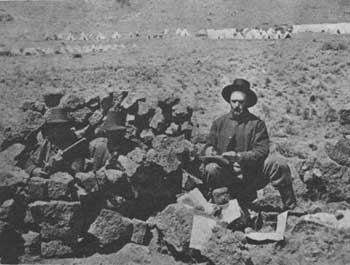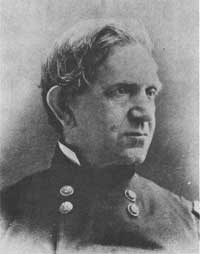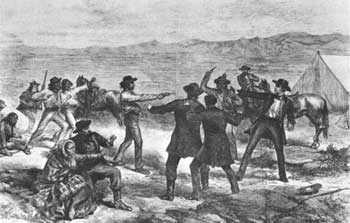





Survey of Historic Sites and Buildings
 |
LAVA BEDS NATIONAL MONUMENT California |
 |
| ||
This national monument, consisting of more than 46,000 acres of solidified lava flow, is geologically as well as historically interesting. The major events of the Modoc War (1872-73), one of the last Indian-soldier clashes in the Pacific Northwest, occurred within its boundaries.
The Modocs, aroused by the intrusion of emigrants, settlers, and ranchers into their homeland on the Lost River along the California-Oregon boundary north of Tule Lake, reacted by a series of assaults on the newcomers. Public demand for their removal heightened. In 1864 they agreed to relocate to the newly opened Klamath Indian Reservation, on Oregon's Upper Klamath Lake. Spurred by repeated conflicts with the Klamath Indians, the following year Captain Jack and most of the Modocs fled to their home country, about 35 miles southeastward. There they resided for 4 years in uneasy coexistence with the settlers and ranchers. In 1869 U.S. officials convinced them to return to the reservation. Still unable to reconcile intertribal differences, the next year they again headed for the Lost River. For 2 years, U.S. representatives pressured Captain Jack to move back onto the reservation.
 |
| Journalists often accompanied troops on the Indian frontier. Here a San Francisco Bulletin correspondent poses with soldiers in California's lava beds during the Modoc War. (National Archives) |
 |
| Gen. Edward R. S. Canby, who died with Rev. Eleasar Thomas at the hands of the Modocs while serving as a peace commissioner. (National Archives) |
Finally, late in November 1872, troops from Fort Klamath, Oreg., proceeded to Captain Jack's village, on the west side of the Lost River near its mouth, at the northwestern corner of Tule Lake, to coerce the band. But, before any discussion could take place, firing broke out on both sides. Some settlers then attacked a second Modoc village, on the east bank of the river. Captain Jack's group retreated southward across Tule Lake in canoes, and the other band traveled by horseback around the eastern side of the lake. Uniting in the north-central region of the lava beds they took cover in a natural fortress of caves, crevices, and twisted masses of lava rock that came to be known as Captain Jack's Stronghold. They managed to exist by eating a herd of cattle they discovered and found other ways to keep alive. On January 17, 1873, about 300 Regular and Volunteer troops opened an attack. Yet the Indians, numbering only 70 or so, repelled them.
Late that month the Secretary of War halted military operations to allow a Department of the Interior peace commission, which included the military department commander, Brig. Gen. Edward R. S. Canby, to try negotiation. At the third truce meeting, on April 11, after a brief exchange of words, the Modocs killed General Canby and another commissioner, the Reverend Eleasar Thomas, both of whom were strong advocates of fair treatment of the Modocs. The rest of the party managed to escape, but the eastern humanitarians whose prodding had brought about the peacemaking attempt, as well as President Grant's Peace Policy, suffered setbacks.
On April 15 about 650 soldiers launched a second assault on the stronghold. When they captured it 2 days later, they found it deserted. For weeks they pursued the band throughout the lava beds and the surrounding region, clashed with it several times, and took a few captives. Eventually the harassed Modocs surrendered. The soldiers apprehended Captain Jack on June 1 and transported him to Fort Klamath, where he and five others stood trial and were convicted of murder. President Grant commuted the sentences of two of them to life imprisonment. In October Captain Jack and three other leaders died on the gallows. Troops escorted the surviving Modocs to a reservation in Indian Territory, and the Pacific Northwest gained several years of peace—but only at the expense of a campaign that had been prolonged beyond all expectations and proved very costly to the military, which suffered 126 casualties.
 |
| Assassination of the Modoc War peace commissioners, a sketch originally appearing in the London Times and reprinted in Harper's Weekly (June 28, 1873). (Library of Congress) |
Museum exhibits, markers, and self-guiding trails interpret the park's geology and history. Noteworthy sites are those of Captain Jack's Stronghold, the Army base camp, the place of Canby's death, and the principal engagements. The terrain is essentially unchanged since the time of the Modoc War.
 |
 |
http://www.cr.nps.gov/history/online_books/soldier-brave/sitea7.htm
Last Updated: 19-Aug-2005